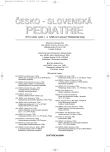Prevention of CAN Syndrome in the Child
Authors:
L. Mazúchová 1; I. Tokárová 2
Authors‘ workplace:
Ústav ošetrovateľstva JLF UK, Martin
vedúca doc. Mgr. K. Žiaková, Ph. D., mim. prof. JLF UK
1; Detská psychiatrická ambulancia, Košice
2
Published in:
Čes-slov Pediat 2009; 64 (1): 28-32.
Category:
Review
Overview
Maltreated, abused and neglected children have their long-lasting hurts to bear. These are the base of many psychogenic diseases, addiction, social maladaptation, unsocial as well as antisocial behavior and delinquency. It is more effective to prevent this problem from growing and repetition than to help and treat the children who have already suffered violence.
Based on case study analysis, the authors point out prevention methods and prevention occasions for an addicted mother with a child in who a potential risk of maltreated and neglected child already exists. With the help of case-records, an addicted mother’s problems in care for her child during the first months of baby’s life get identified. Risk factors in mother and child are referred to from the standpoint of maltreatment and neglect prevention and solutions for effective help are looked for.
Key words:
maltreatment, neglect, CAN syndrome, prevention, risk
Sources
1. Dunovský J, Dytrych Z, Matějček Z, et. al. Týrané, zneužívané a zanedbávané dítě. Praha: Grada, 1995 : 1–248.
2. Buchanec J, Fedor M, Buchancová J. CAN syndróm – niektoré osobitné jeho formy. Čes.-slov. Pediat. 2004;59(6): 278–282.
3. Biskup P. Diagnostika syndrómu týraného, zneužívaného a zanedbávaného dítěte – doporučený postup určený lékářům primární péče. Čes.-slov. Pediat. 2001;56(4): 225–230.
4. Gjuričová Š, Kocourková J, Koutek J. Podoby násilí v rodině. 1. vyd. Praha: Vyšehrad, 2000 : 1–101.
5. Clark MJ. Nursing in the Community. Norwalk, Connenticut: Appleton & Lange, 1992 : 1–975.
6. Briere J. Child Abuse Trauma. Theory and Treatment of the Lasting Effects. London: Sage Publications, 1992 : 1–203.
7. Černay J. Sociálne problémy v pediatrii – sociálna pediatria. Trnava: Slovak Academic Press, 2005 : 1–108.
8. Dunovský J. Ochrana dětí v České republice a Úmluva o právech dítěte. Čas. Lék. čes. 2003;142(10): 630–635.
9. Bosáková K, Bosák V, Kučera Z, et.al. Psychické týraní v dětství u dospělé populace ČR: výskyt a některé souvislosti. Čes.-slov. Pediat. 2003;58(11): 716–721.
10. Říčan P, Krejčírová D, et. al. Dětská klinická psychologie. 1.vyd. Praha: Grada Publishing, 1995 : 1–398.
11. Vlčková M. Úloha sociálneho pracovníka pri detekcii týraného dieťaťa. Vychovávateľ 2005;LI(3): 7–10.
12. Šporcrová I. Potřeby dětí a jejich uspokojování v systémech sociálních sítí. Čes.-slov. Pediat. 2003;58(4): 222–226.
13. Rushton FE. The role of health care in child abuse and neglect prevention. J. S. C. Med. Assoc. 1996;92(3): 133–136.
14. Sejčová Ľ. Deti a mládež ako obete násilia. 1. vyd. Bratislava: Album, 2001 : 1–208.
15. Doyle C. Práca s týraným dieťaťom. 2. vyd. Londýn: BASW, 1999 : 1–178.
16. Roussey M, Bellec S, et al. Assisting psychosocially distressed mothers-to-by: Primary prevention of child abuse. Child Abuse and Neglect 1993;17(5): 687–690.
17. Schneider J, Frenzi L. Program of home visits – Hana Like. Journal of Psychohistory 1993;21(1): 29–36.
18. Bannon MJ, Carter YH, Barwell F, et. al. Perceptions held by general practitioners in England regarding their training needs in child abuse and neglect. Child Abuse Review 1999;8(4): 276–283.
19. Janosiková E, Daviesová J. Psychiatrická ošetrovateľská starostlivosť: Duševné zdravie a psychiatrické ošetrovateľstvo. 1. vyd. Martin: Osveta, 1999 : 1–551.
20. Browne KD, Hamilton CE, Heggerty J, et. al. Identifying need and protecting children trough community nursing home visists. Representing Children 2000;13(2): 111–123.
Labels
Neonatology Paediatrics General practitioner for children and adolescentsArticle was published in
Czech-Slovak Pediatrics

2009 Issue 1
- What Effect Can Be Expected from Limosilactobacillus reuteri in Mucositis and Peri-Implantitis?
- The Importance of Limosilactobacillus reuteri in Administration to Diabetics with Gingivitis
Most read in this issue
- Prevention of CAN Syndrome in the Child
- Anatomical, Embryological and Ethical Aspect of Conjoined (Siamese) Twins
- Recommendation for Diagnostics and Therapy of Hypertension in Children and Adolescents Elaborated by the Working Group of Pediatric Cardiology
- Development of Crohn’s Disease during the Course of HLA B27+ Juvenile Idiopathic Arthritis
